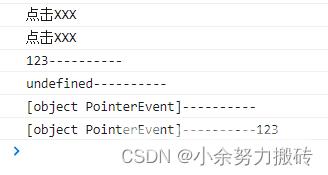一、v-on的基本用法 使用 v-on:click 给button绑定监听事件以及回调函数,@是 v-on: 的缩写,也就是简写也可以使用 @click 。方法一般是需要写方法名加上(),在 @click 中可以省掉,如上述的
一、v-on的基本用法
使用v-on:click给button绑定监听事件以及回调函数,@是v-on:的缩写,也就是简写也可以使用@click。方法一般是需要写方法名加上(),在@click中可以省掉,如上述的<button @click="increment">加</button>。
以简单的计数器为例
<body>
<div id="app">
<h2>{{count}}</h2>
<!-- <button v-on:click="count++">加</button>
<button v-on:click="count--">减</button> -->
<button @click="increment">加</button>
<button @click="decrement">减</button>
</div>
<script>
const app = new Vue({
el:"#app",
data:{
count:0
},
methods: {
increment(){
this.count++
},
decrement(){
this.count--
}
}
})
</script>
</body>
二、v-on的参数传递
在methods中定义的方法,我们可以进行调用,可以带上(),也可以不带()
如下的btnClick的调用中,加了()想要调用,里面必须要有值,如果不加小括号,就只会调用事件对象。
btnClick3想要传入event,需要在调用时写$event,才能调用事件对象。
<div id="app">
<!-- 事件没传参 -->
<button @click="btnClick">按钮1</button>
<button @click="btnClick()">按钮2</button>
<!-- 事件调用方法传参,写函数时候省略小括号,但是函数本身需要传递一个参数 -->
<button @click="btnClick2(123)">按钮3</button>
<button @click="btnClick2()">按钮4</button>
<button @click="btnClick2">按钮5</button>
<!-- 事件调用时候需要传入event还需要传入其他参数 -->
<button @click="btnClick3($event,123)">按钮6</button>
</div>
<script src="vue.js"></script>
<script>
const app = new Vue({
el:"#app",
methods:{
btnClick(){
console.log("点击XXX");
},
btnClick2(value){
console.log(value+"----------");
},
btnClick3(event,value){
console.log(event+"----------"+value);
}
}
})
</script>

事件没传参,可以省略()事件调用方法传参了,写函数时候省略了小括号,但是函数本身是需要传递一个参数的,这个参数就是原生事件event参数传递进去如果同时需要传入某个参数,同时需要event是,可以通过$event传入事件。
三、v-on的修饰词
.stop的使用,btn的click事件不会传播,不会冒泡到上层,调用event.stopPropagation()。
.prevent调用event.preeventDefault阻止默认行为。
.enter监听键盘事件;
once事件只触发一次(常用);
capture使用事件的捕获模式;
self只有event.target是当前操作的元素时才触发事件;
passive事件的默认行为立即执行,无需等待事件回调执行完毕;
<style>
.div {
height:80px;
background:#f00;
}
</style>
</head>
<body>
<div id="app">
<!--1. .stop的使用,btn的click事件不会传播,不会冒泡到上层,调用event.stopPropagation() -->
<div @click="divClick">
<button @click.stop="btnClick">按钮1</button>
</div>
<!-- 2. .prevent 调用event.preeventDefault阻止默认行为 -->
<form action="www.baidu.com">
<button type="submit" @click.prevent="submitClick">提交</button>
</form>
<!--3. 监听键盘的事件 -->
<form @submit.prevent=''>
账号<input type="text" name="user"/>
密码<input type="text" name="password" @keyup.enter="submit"/>
<input type="submit" value="登录"/>
</form>
<!--4. 事件只触发一次(常用) -->
<button @click.once="showInfo">点我提示信息</button>
<!--5. capture使用事件的捕获模式 -->
<div class="box1" @click.capture="show(111)">
div1外面
<div class="box2" @click="show(222)">
div2里面
</div>
</div>
<!-- 6.只有event.target是当前操作的元素时才触发事件 -->
<div class="div" @click.self="showself">
<button @click="showself">点我</button>
</div>
<!-- 7.passive事件的默认行为立即执行,无需等待事件回调执行完毕 -->
</div>
<script src="vue.js"></script>
<script>
const app = new Vue({
el:"#app",
methods:{
btnClick(){
console.log("点击button");
},
divClick(){
console.log("点击div");
},
submitClcik(){
console.log("提交被阻止了")
},
submit(){
console.log("keyup点击")
},
showInfo(){
alert('web学习真有趣')
},
show(msg){
console.log(msg)
},
showself(e){
console.log(e.target);
},
}
})
</script>
</body>
到此这篇关于Vue中v-on的基础用法、参数传递和修饰符的文章就介绍到这了,更多相关Vue中v-on参数传递和修饰符内容请搜索易盾网络以前的文章或继续浏览下面的相关文章希望大家以后多多支持易盾网络!
